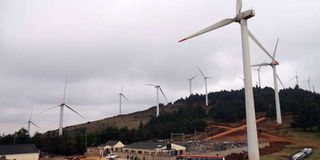Rising power demand a big policy headache

The Ngong wind power farm in Kajiado County. FILE PHOTO | SALATON NJAU | NATION MEDIA GROUP
What you need to know:
- Today, the population has grown more than 17 times since Kenya Power was established in 1922.
- With expansion of the economy came the change in lifestyles, raising demand for electricity and presenting the country with a huge headache to meet the ballooning needs at an affordable rate.
- The government is already in a tight race to meet two ambitious plans by June 2017; connect 70 per cent of households to the main grid and add 5,000MW of installed capacity to the system.
When the Electric Power and Lighting Company and the Nairobi Power and Lighting merged in 1922 to give birth to the electricity sub sector, Kenya’s priority was far from deepening connection to any significant portion of its population.
The country had a narrow manufacturing sector and the population was below 2.5 million whose main sources of power was biomass.
Today, the population has grown more than 17 times and with the expansion of the economy came the change in lifestyles, raising demand for electricity and presenting the country with a huge headache to meet the ballooning needs at an affordable rate.
The government is already in a tight race to meet two ambitious plans by June 2017; connect 70 per cent of households to the main grid and add 5,000MW of installed capacity to the system.
The big challenge now lies in managing the future generational mix as well as consumption patterns of the new entrants to the grid, which has been rapid in the last three years, deepening the complexity.
Already 55 per cent of households have been hooked to the main grid, representing about 25 million people as the government banks on the Last Mile connectivity programme to achieve the universal power access plan by 2020.
With 22,245 schools connected to power and another 1,000 in the next few months, 35 towns and urban centres in 27 counties have been lit since 2013 under the Sh7.6 billion street-lighting programme targeting 65 major urban centres across the country, the challenge ahead is real.
Smart Company delved into the future of the country’s largely renewable generation mix, which has been lauded internationally to find out whether Kenya’s plan will need a shift of focus on the generation mix.
Will the country continue to enjoy both cheaper and greener power amidst the growing connectivity? How about stability of the power and what diversification is required in the mix to meet the ambitious plans?
The Energy Regulatory Commission director-general Joseph Ng’ang’a said the country has been enjoying the largely renewable sources combination due to the low installed capacity and the low demand over time.
According to Mr Ng’ang’a Kenya will have to be strategic in determining which sources will fit the projected demands at the least cost to keep power accessible and affordable.
“Based on our focused consumption, including the new industries coming into the power demand structure like the Konza City, electrification of the SGR, the special economic zones, and growing middle class with people having more equipment, we have to look at how to meet these demands at the least cost way possible,” Mr Ng’ang’a said.
“With this then we may need to add say 1,000MW into the grid. Now the largest geothermal plant we have produces 70MW, meaning we may need several of these to generate the 1,000MW.
Coal, which starts from 300MW in one plant would, for example, be ideal if you want to get the economies of scale.” Kenya is also said to have enjoyed the installation and use of geothermal sources because of their low operational costs and their high load factor (meaning they can run almost non-stop).
The county has also been pursuing generation of nuclear power by 2033 with a recent signing of an agreement between Korea Electricity Power Corp (KEPCO) and the Kenya Nuclear Electricity Board being a major boost in the 4,000MW scheme.
Mr Nga’ng’a said the fears expressed over the plan are not realistic.
“You see, the rule of the thumb in power generation is that the biggest unit your system should not exceed 10 per cent of your installed capacity so that in case it was to come out of the system then there would be no crisis. That is why in our case we could only have allowed 150MW at most. But that is changing and with the growing demand and the need to keep costs low, these are the options we have,” he said.
Kenya’s biggest plant currently is the 85MW Gitaru hydro plant. There are also plans to put up a 981MW coal plant at the Coast as part of the scheme to add 5,000MW into the national grid.
The country’ daily demand curve sees the majority of households using power during the evening between 6-10 pm, which makes it hard to run the base sources without involving the easy-to-start diesel powered plants at the centre of the power purchase agreements.
South Africa, which has 45,000MW of installed capacity has more than 90 per cent sourced from coal. The country which projects to add over 40,000MW by 2025 is currently putting up another 9,600MW coal plant.
Kenya’s coal plant expected to be constructed in Lamu County has been opposed by community, citing environmental and health risks.
Data from the International Energy Association indicates that most of the developed counties have very low green energy mix, including the USA whose renewable mix is below 10 per cent.
The ERC, which is tasked with ensuring there is affordability, sustainability and quality of energy to ensure that the country is competitive, however, says there will be minimal risk as the sources will be properly vetted by the authority before licensing.




